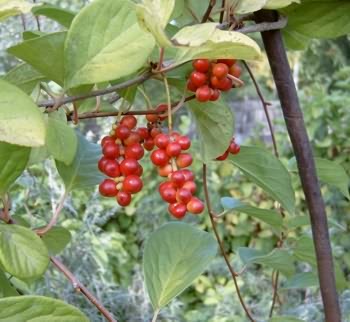Relatives
Schisandra chinensis (Turcz.) Baill. - Chinese magnolia vine.
Taxonomic position.
Family Schisandraceae Blume genus Schisandra Michx.Synonyms.
Kadsura chinensis Turcz.Morphology and biology.
Monoecious or less frequently dioecious perennial plant. Deciduous, ligneous and climbing liana, up to 8 (15) m in length and 2 cm in diameter. Bark is fulvous brown, peeling. Leaves are alternate, simple, entire, elliptical or obovate, 5-7(10) cm long and 3-5 cm wide, acute, with a wedge-shaped base and few weakly expressed denticles along the edge, naked and dark green from above, while from below feebly pubescent along the veins. When dried for herbaria, leaves usually turn black. Petioles are reddish, up to 3 cm long. Flowers are diclinous, with a simple corolla-like perianth, fragrant, usually clustered by 3-5 in leaf axils, set on drooping pedicels up to 4 cm long. The perianth consists of 6-9 lobes; it is white, waxy, up to 2 cm in diameter. Stamens are numerous, accreted into a column. The ovary is simple. After fading the receptacle becomes significantly longer (40-50 times), reaching 7-9 cm in length; affixed thereon are numerous red and very juicy globular dispermous follicles, looking like berries. One flower would form a compound fruit in the likeness of a non-ramose raceme. All parts of the plant have a specific smell resembling the odor of lemon.Insect-pollinated. Ornito- and zoochore. Propagated by seed, root and softwood cuttings, layers, and crown division. Seeds need to be stratified for 4 months at 2-5 degrees Centigrade. Blossoms in June or the first half of July; bears fruit in September. 2n=28.
Distribution.
Russian Far East (Amur Province, Primorsky Region, south of Khabarovsk Region, Southern Sakhalin, the Kuriles - Shikotan, Kunashir, Iturup), China, Korea, and Japan.Ecology.
Mesophyte. Grows in coniferous-broadleaved and mixed deciduous forests, preferring well-drained soils along rivulets and brooks. Ascends the mountains up to 600-1000 m above sea levelUtilization and economic value.
Valuable food and medicinal plant. Its fruit and leaves are used to prepare restorative and recuperative medication. Melliferous. Ornamental. Recommended for vertical green landscaping and skirting.References:
Kharkevich SS., ed. 1996. Vascular plants of the Soviet Far East. V.8. Leningrad: Nauka, 383 p (In Russian).Koropachinskiy I Yu, Vstovskaya TN. 2002. Woody plants of the Asian part of Russia. Novosibirsk: Publishing House of SB RAS, Branch "Geo", 707 p (In Russian).


